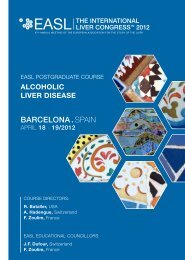EASL clinical practice guidelines for HFE Hemochromatosis
EASL clinical practice guidelines for HFE Hemochromatosis
EASL clinical practice guidelines for HFE Hemochromatosis
Create successful ePaper yourself
Turn your PDF publications into a flip-book with our unique Google optimized e-Paper software.
Article in Press 11Clinical Practice GuidelinesTable 7. Methods <strong>for</strong> <strong>HFE</strong> genotyping.MethodSimultaneous detection of multiple mutationsDetection of novel/rare genetic variationsAmenable <strong>for</strong> high throughputSpecialized equipment requiredReference(s)RFLP PCR amplification followed by restriction fragment length polymorphism − − − +/− [148–150]Direct sequencing PCR amplification followed by direct sequencing + + − − [151–154]Allelic discrimination PCR Real time PCR (TaqMan ® ) with displacing probes and modifications − − +/− +/− [155–160]Melting curve analysis (Light Cycler ® ) + + +/− +/− [161,162]D-HPLC Denaturing HPLC + + +/− + [163]SSP Sequence specific priming PCR − − − + [164–170]SPA Solid-phase amplification − − − + [171]SSCP Single strand con<strong>for</strong>mation polymorphism analysis + + − +/− [172,173]OLA Oligonucleotide ligation assay − − − + [148]SCAIP Single-condition amplification with internal primer +/− +/− − + [151]Advanced read-out Mass spectrometry based, capillary electrophoresis, chip based n/a n/a n/a + [174–179]Reverse hybridization assay Multiplex PCR amplification followed by reverse hybridization n/a n/a n/a + [21,150,180,181]Novel extraction methods Dried blood spots, whole-blood PCR n/a n/a n/a ++ [38,158,182]Increased body iron storesSerum ferritinThe most widely used biochemical surrogate <strong>for</strong> iron overload isserum ferritin. According to validation studies where body ironstores were assessed by phlebotomy, serum ferritin is a highlysensitive test <strong>for</strong> iron overload in hemochromatosis [21]. Thus,normal serum concentrations essentially rule out iron overload.However, ferritin suffers from low specificity as elevated valuescan be the result of a range of inflammatory, metabolic,and neoplastic conditions such as diabetes mellitus, alcoholconsumption, and hepatocellular or other cell necrosis.Serum iron concentration and transferrin saturation do notquantitatively reflect body iron stores and should there<strong>for</strong>e notbe used as surrogate markers of tissue iron overload.There<strong>for</strong>e, in <strong>clinical</strong> <strong>practice</strong>, hyperferritinemia may beconsidered as indicative of iron overload in C282Y homozygotesin the absence of the confounding factors listed above.ImagingMagnetic resonance imaging (MRI): The paramagnetic propertiesof iron have been exploited to detect and quantify iron byMRI. The ‘gradient recalled echo techniques’ are sensitive whenusing a well-calibrated 1.5 Tesla device. There is an excellentinverse correlation between MRI signal and biochemical hepaticiron concentration (HIC) (correlation coefficient: −0.74 to −0.98)allowing <strong>for</strong> the detection of hepatic iron excess within therange 50–350 mmol/g with a 84–91% sensitivity and a 80–100% specificity according to cut-off levels of HIC rangingfrom 37 to 60 mmol/g wt [196–198]. MRI may also help to(i) identify heterogeneous distribution of iron within the liver,(ii) differentiate parenchymal (normal splenic signal and lowhepatic, pancreatic, and cardiac signals) from mesenchymal(decreased splenic signal) iron overload, and (iii) detect smalliron-free neoplastic lesions. However, only a few patients with<strong>HFE</strong>-proven HC were studied [197].Superconducting quantum interference device (SQUID) susceptometer:The SQUID susceptometer allows <strong>for</strong> in vivomeasurement of the amount of magnetization due to hepaticiron. Results are quantitatively equivalent to biochemicaldetermination on tissue obtained by biopsy. However, the devicewas not specifically validated in <strong>HFE</strong>-HC patients. In addition,it is not widely available, which restricts its use in <strong>clinical</strong>routine [199–201].Liver biopsyLiver biopsy used to be the gold standard <strong>for</strong> the diagnosis of HCbe<strong>for</strong>e <strong>HFE</strong> genotyping became available. Now that this is readilyavailable, homozygosity <strong>for</strong> C282Y in patients with increasedbody iron stores with or without <strong>clinical</strong> symptoms is sufficientto make a diagnosis of <strong>HFE</strong>-HC.Where there is hyperferritinemia with confounding cofactors,liver biopsy may still be necessary to show whether iron storesare increased or not [98]. Liver biopsy still has a role in assessingliver fibrosis. The negative predictive value of serum ferritin












